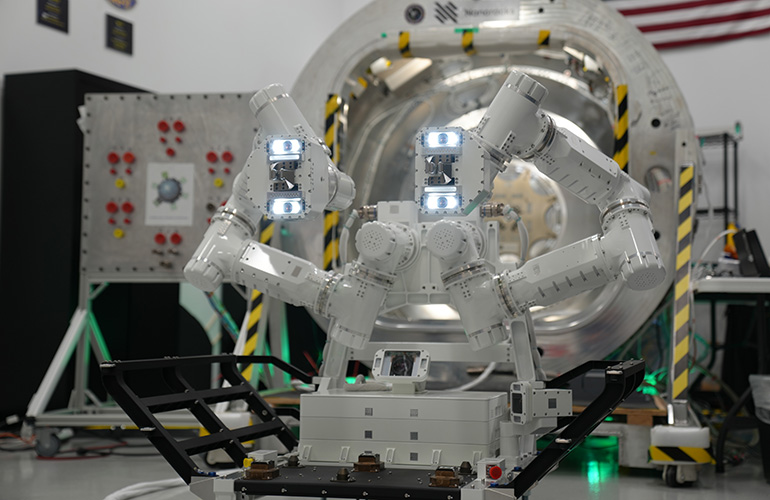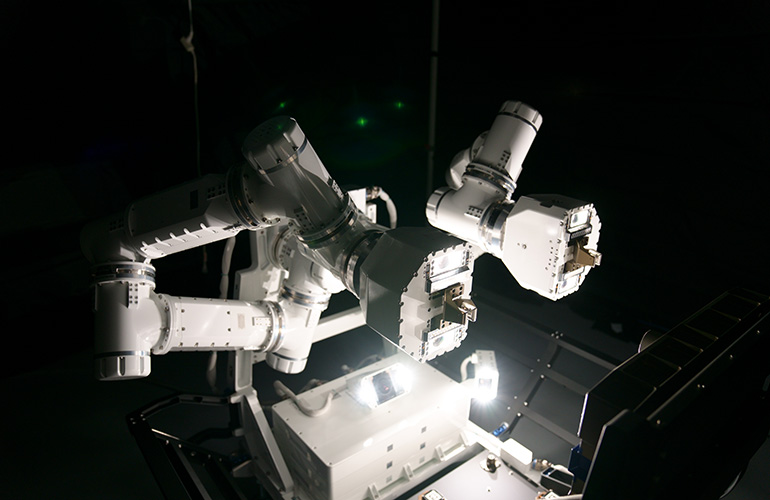|
Listen to this article |

GITAI’s S2 dual-armed robot system will conduct various tasks at the International Space Station. | Source: GITAI
GITAI USA Inc.’s latest robotic system, S2, this week launched aboard a SpaceX Falcon 9 rocket headed for the International Space Station. It is part of a mission to resupply the ISS and to test innovations including a surgical robot and a metal 3D printer. The system arrived today.
S2 is the Torrance, Calif.-based company’s dual-armed robotic system. Now that it has been delivered, the ISS crew will mount S2 on the Nanorack Bishop Airlock, and the robot conduct an external demonstration of in-space servicing, assembling, and manufacturing (ISAM).
“Our robotics systems are capable of conducting various operations, such as maintenance, inspection, and life extension operations for the target satellite,” stated Sho Nakanose, the founder and CEO of GITAI.
 Learn from Agility Robotics, Amazon, Disney, Teradyne and many more.
Learn from Agility Robotics, Amazon, Disney, Teradyne and many more.
Inside GITAI’s manipulator robot
GITAI said it designed S2 for reliability and flexibility. The company built all of its technology with components developed completely in-house, so it can commercialize those components in the future, noted Nakanose.
“Unfortunately, there weren’t any good suppliers in the market,” he told The Robot Report. “The space robotics field is a very new business domain. So there’s no supply chain in the industry. So if we wanted highly capable and affordable robotics for spacecrafts, we needed to develop everything in-house.”
GITAI equipped S2 with two 1.5 meter (5 ft.)-long arms that the company said will enhance its work performance. This will be the first time GITAI will test its dual-armed system at the ISS.
The company’s previous demonstration onboard the ISS involved its S1 autonomous space robot. S1 only has one arm, and was able to execute two tasks: assembling structures and panels for in-space assembly (ISA), and operating switches and cables for intravehicular activity (IVA).
“For our first demonstration, we had to realize the performance of the robotic system and show it’s capable of conducting very complex operations, such as assembling smaller parts,” Nakanose said.
S2’s jobs on the ISS
Along with demonstrating the benefits of having two robotic arms work in cooperation, S2 plans to show off GITAI’s new tool changer. The company said it hopes to prove the general-purpose tool changer’s precision and robustness.
Nakanose said the tool changer is a key part of S2. GITAI’s customers, which are spending large amounts of money to even get this technology into space, are interested in systems that can do a lot of work, so flexibility is key, he said.
“As far as our ISS demonstration, we have two kinds of end effectors,” explained Nakanose. “One is, of course, a pinching robotic hand, and the other is a robotic screwdriver.”
S2 will have four tasks it needs to perform on the ISS. The first is installing a task panel in place. According to GITAI, component replacement is important for space station maintenance and satellite life. Robots like S2 could provide more precise manipulation than human astronauts.
In addition, S2 will screw and unscrew tiny captive bolts robotically, as well as demonstrate its ability to manipulate sheets of flexible materials like thermal blankets. Finally, S2 will mate and de-mate a flexible electric cable with a connector that is tied to the ISS.

GITAI’s S2 robotic system with its pinching grippers, which can be used to precisely place parts. | Source: GITAI
GITAI readies S2 for the ISS, future missions
Before GITAI and SpaceX could launch S2 to the ISS, the robot needed to pass all of NASA’s Safety Reviews and achieve NASA’s Technology Readiness Level (TRL) 6. According to Nakanose, NASA’s Safety Reviews are exhaustive, as NASA needs to ensure any technology heading to the ISS is completely safe for astronauts to work around.
“With spacecrafts, there’s a history of robotic systems being very complex and risky for [NASA],” Nakanose said. “So, it’s a really important program. We had to make sure our product is totally safe, and our system has necessary countermeasures for safety.”
“We succeeded in passing all the National Safety review in probably 10 months,” Nakanose said. “So it’s very quick. Generally speaking, you will take a few years to pass the safety review.”
By completing this mission, GITAI said it aims to reach TRL 7. NASA’s TRL system is used to assess the maturity levels of a particular technology. Level 7 means that the system prototype has been demonstrated in a space environment.
At Level 9, the highest level, NASA declares that a system has been flight-proven through successful mission operations.
Moving forward, GITAI has a number of customer contracts on the horizon. Nakanose said they include contracts with Toyota and JAXA, the Japanese Aerospace Exploration Agency, and a DARPA contract to use its robots to build infrastructure on the Moon.





